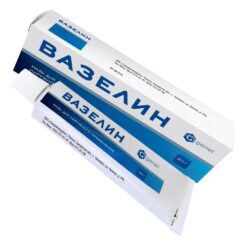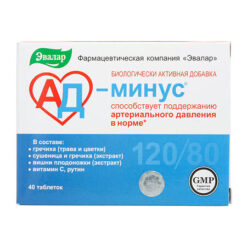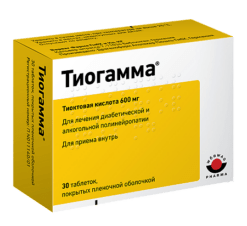-
×


-
×


-
×


Subtotal: €35.27






Subtotal: €35.27






Subtotal: €35.27
€26.72 €22.27
Out of stock
(E-mail when Stock is available)
PHARMACODINAMICS
Venlafaxine is an antidepressant chemically unrelated to any class of antidepressants (tricyclic, tetracyclic or other) and is a racemate of two active enantomers.
The mechanism of antidepressant effects of the drug is related to its ability to potentiate nerve impulse transmission in the central nervous system (CNS). Venlafaxine and its main metabolite O-desmethylvenlafaxine (ODV) are strong serotonin and noradrenaline reuptake inhibitors and weak dopamine reuptake inhibitors. In addition, venlafaxine and O-desmethylvenlafaxine reduce beta-adrenergic reactivity after both single administration and continuous administration. Venlafaxine and EFA are equally effective on neurotransmitter reuptake.
Venlafaxine has no affinity for muscarinic, cholinergic, histamine (H1), and a1-adrenergic brain receptors. Venlafaxine does not inhibit monoamine oxidase (MAO) activity. It has no affinity for opiate, benzodiazepine, phencyclidine or N-methyl-d-aspartate (NMDA) receptors.
PHARMACOKINETICS
Venlafaxine is well absorbed from the gastrointestinal tract. After a single dose of 25-150 mg, maximum plasma concentrations reach 33-172 ng/mL within approximately 2.4 hours. It is metabolized extensively during its first passage through the liver. Its main metabolite is O-desmethylvenlafaxine (ODV). The elimination half-life of venlafaxine and EFA is 5 and 11 hours, respectively. Maximum plasma concentrations of EFA of 61-325 ng/ml are reached approximately 4.3 hours after administration. Binding of venlafaxine and EFA to plasma proteins is 27% and 30%, respectively. EFA and other metabolites, as well as unmetabolized venlafaxine, are excreted by the kidneys. When administered repeatedly, equilibrium concentrations of venlafaxine and EFA are reached within 3 days. In the daily dose range of 75-450 mg, venlafaxine and EFA have linear kinetics. After taking the drug with a meal, the time to reach maximum plasma concentration is increased by 20-30 minutes, but the values of maximum concentration and absorption do not change.
In patients with cirrhosis, plasma concentrations of venlafaxine and EFA are elevated and their elimination rate is reduced. In moderate or severe renal failure, total clearance of venlafaxine and EFA is decreased and the elimination half-life is prolonged. A decrease in total clearance is mainly observed in patients with creatinine clearance below 30 ml/min.
Age and gender of the patient do not affect the pharmacokinetics of the drug.
Depression of various etiologies, treatment and prevention.
PHARMACODYNAMICS
Venlafaxine is an antidepressant that does not chemically belong to any class of antidepressants (tricyclic, tetracyclic or others), and is a racemate of two active enantomers.
The mechanism of the antidepressant effect of the drug is associated with its ability to potentiate the transmission of nerve impulses in the central nervous system (CNS). Venlafaxine and its main metabolite O-desmethylvenlafaxine (ODV) are strong serotonin and norepinephrine reuptake inhibitors and weak dopamine reuptake inhibitors. In addition, venlafaxine and O-desmethylvenlafaxine reduce beta-adrenergic reactivity both after a single dose and with chronic use. Venlafaxine and EDV are equally effective in inhibiting neurotransmitter reuptake.
Venlafaxine has no affinity for muscarinic, cholinergic, histamine (H1) and α1-adrenergic receptors in the brain. Venlafaxine does not inhibit monoamine oxidase (MAO) activity. Has no affinity for opiate, benzodiazepine, phencyclidine, or N-methyl-d-aspartate (NMDA) receptors.
PHARMACOKINETICS
Venlafaxine is well absorbed from the gastrointestinal tract. After a single dose of 25-150 mg, the maximum plasma concentration reaches 33-172 ng/ml within approximately 2.4 hours. Subject to intensive metabolism during the first passage through the liver. Its main metabolite is O-desmethylvenlafaxine (ODV). The half-lives of venlafaxine and EDV are 5 and 11 hours, respectively. The maximum concentration of EDV in blood plasma of 61-325 ng/ml is achieved approximately 4.3 hours after administration. The binding of venlafaxine and EDV to plasma proteins is 27% and 30%, respectively. EDV and other metabolites, as well as unmetabolized venlafaxine, are excreted by the kidneys. With repeated administration, equilibrium concentrations of venlafaxine and EDV are achieved within 3 days. In the range of daily doses of 75-450 mg, venlafaxine and EDV have linear kinetics. After taking the drug with food, the time to reach maximum concentration in the blood plasma increases by 20-30 minutes, but the values of maximum concentration and absorption do not change.
In patients with liver cirrhosis, plasma concentrations of venlafaxine and EDV are increased, and their elimination rate is reduced. In moderate or severe renal impairment, the total clearance of venlafaxine and EDV is reduced and the half-life is prolonged. A decrease in total clearance is mainly observed in patients with creatinine clearance below 30 ml/min.
The age and gender of the patient do not affect the pharmacokinetics of the drug.
Discontinuation of Venlafaxor: As with other antidepressants, abrupt cessation of venlafaxine therapy – especially after high doses of the drug – may cause withdrawal symptoms, and therefore it is recommended to gradually reduce the dose before discontinuing the drug.
When prescribing Venlaxor tablets to patients with lactose intolerance, the lactose content should be taken into account (30 mg in each tablet 37.5 mg; 60 mg in each tablet 75 mg).
In patients with depressive disorders, the possibility of suicide attempts should be considered before starting any drug therapy. Therefore, to reduce the risk of overdose, the initial dose of the drug should be as low as possible, and the patient should be under close medical supervision.
In patients with mood disorders, hypomanic or manic states may occur when treated with antidepressants, including venlafaxine. Like other antidepressants, venlafaxine should be used with caution in patients with a history of mania. Such patients require medical supervision.
Like other antidepressants, venlafaxine should be administered with caution to patients with a history of epileptic seizures. Treatment with venlafaxine should be interrupted if epileptic seizures occur.
Although venlafaxine does not affect psychomotor and cognitive functions, it should be taken into account that any drug therapy with psychoactive drugs may reduce the ability to make judgments, think or perform motor functions. The patient should be warned about this before starting treatment. If such effects occur, the degree and duration of restrictions should be determined by a physician. Drinking alcohol is also not recommended.
Venlafaxine
1 tablet contains 37.5 mg or 75 mg of venlafaxine (as hydrochloride).
Excipients: anhydrous calcium hydrogen phosphate, anhydrous lactose, sodium carboxymethyl starch, magnesium stearate, anhydrous colloidal silicon dioxide, red iron oxide dye (E 172).
The use of the drug during pregnancy (or suspected pregnancy) is contraindicated.
If maternal treatment was completed shortly before delivery, the newborn may experience drug withdrawal symptoms.
Venlafaxine and its metabolite (EFV) are excreted into breast milk. Taking venlafaxine during breastfeeding is not recommended; if it is necessary to take the drug, the issue of stopping breastfeeding should be decided.
Hypersensitivity. Simultaneous use of MAO inhibitors (see also section “Interaction”). Severe renal and/or liver dysfunction (glomerular filtration rate (GFR) less than 10 ml/min). Age up to 18 years (safety and effectiveness for this age group have not been proven). Established or suspected pregnancy. Lactation period.
With caution: recent myocardial infarction, unstable angina, arterial hypertension, tachycardia, history of convulsive syndrome, increased intraocular pressure, angle-closure glaucoma, history of manic states, predisposition to bleeding from the skin and mucous membranes, initially reduced body weight, hyponatremia, hypovolemia, simultaneous use diuretics, suicidal tendencies, renal/liver failure.
Most of the side effects listed below are dose dependent. With long-term treatment, the severity and frequency of most of these effects decreases, and there is no need to discontinue therapy. Depending on the frequency of occurrence, the following groups of side effects are distinguished: frequent – more than 1%, infrequent – 0.1-1%, rare – 0.01-0.1%, very rare – less than 0.01%.
From the nervous system: often – dizziness, asthenia, insomnia, nightmares, increased nervous excitability, paresthesia, muscle hypertonicity, tremor, sedation; infrequently – apathy, hallucinations, myoclonus, fainting; rarely – convulsions, manic disorders, neuroleptic malignant syndrome.
From the cardiovascular system: often – increased blood pressure, hyperemia of the skin; uncommon – decreased blood pressure, postural hypotension, tachycardia; very rarely – changes in the Q-T interval, ventricular fibrillation, ventricular tachycardia (including ventricular fibrillation).
From the digestive system: often – loss of appetite, nausea, vomiting; infrequently – bruxism (involuntary grinding of teeth), increased activity of “liver” transaminases; rarely – hepatitis.
From the genitourinary system: often – decreased libido, impaired erection and/or ejaculation, anorgasmia, menorrhagia, impaired urination; infrequently – urinary retention, impaired orgasm in women.
From the senses: often – disturbance of accommodation, mydriasis, visual impairment; infrequently – disturbance of taste perception.
From the hematopoietic organs: frequency unknown – agranulocytosis, aplastic anemia, neutropenia, pancytopenia.
Allergic reactions: uncommon – rash, photosensitivity; very rarely – exudative erythema multiforme (including Stevens-Johnson syndrome), anaphylaxis.
Laboratory indicators: infrequently – thrombocytopenia; rarely – increased bleeding time, hyponatremia; with long-term administration and use of high doses – hypercholesterolemia.
Other: often – weight loss, sweating (including night sweats); uncommon – ecchymosis, weight gain; rarely – syndrome of inadequate secretion of antidiuretic hormone, serotonin syndrome (nausea, vomiting, abdominal pain, diarrhea, flatulence, psychomotor agitation, tachycardia, hyperthermia, muscle rigidity, convulsions, myoclonus, sweating, depression of consciousness of varying severity).
If withdrawal syndrome occurs: dizziness, headache, asthenia, increased fatigue, sleep disturbances (changes in the nature of dreams, drowsiness or insomnia, difficulty falling asleep), hypomania, anxiety, increased nervous excitability, confusion, paresthesia, increased sweating, dry mouth, decreased appetite, nausea, vomiting, diarrhea (most of These reactions are mild and do not require treatment)
The simultaneous use of monoamine oxidase inhibitors (MAOIs) and venlafaxine is contraindicated.
Haloperidol: the effect of the latter may be enhanced due to increased blood levels of the drug when used together.
When used simultaneously with clozapine, an increase in its level in the blood plasma and the development of side effects (for example, epileptic seizures) may be observed.
Strengthens the effect of alcohol on psychomotor reactions.
While taking venlafaxine, special caution should be exercised during electroconvulsive therapy, as there is no experience with the use of venlafaxine in these conditions.
Drugs metabolized by cytochrome P 450 isoenzymes:
The main route of elimination of venlafaxine involves metabolism by CYP2D6 and CYP3A4; therefore, special caution should be exercised when prescribing venlafaxine in combination with drugs that inhibit both of these enzymes. Such drug interactions have not yet been studied.
When taken simultaneously with warfarin, the anticoagulant effect of the latter may be enhanced.
When taken concomitantly with indinavir, the pharmacokinetics of indinavir changes (with a 28% decrease in the area under the AUC curve and a 36% decrease in the maximum concentration Cmax), but the pharmacokinetics of venlafaxine and EDV do not change. However, the clinical significance of this effect is unknown.
Symptoms: ECG changes (prolongation of the QT interval, bundle branch block, expansion of the QRS complex), sinus or ventricular tachycardia, bradycardia, hypotension, convulsive states, changes in consciousness (decreased level of wakefulness). Death has been reported in overdoses of venlafaxine when taken concomitantly with alcohol and/or other psychotropic drugs.
Treatment: symptomatic. Specific antidotes are unknown. Inducing vomiting is not recommended due to the risk of aspiration. Venlafaxine and EDV are not eliminated by dialysis.
In a place protected from light at a temperature not exceeding 25 ° C.
Keep out of the reach of children!
3 years. Do not use after the expiration date stated on the package.
Grindeks JSC, Latvia
| Shelf life | 3 years. Do not use after the expiration date stated on the package. |
|---|---|
| Conditions of storage | Store in a light-protected place at a temperature not exceeding 25 °C. Keep out of reach of children! |
| Manufacturer | Grindex JSC, Latvia |
| Medication form | pills |
| Brand | Grindex JSC |
Buy Venlaksor, tablets 37.5 mg 30 pcs with delivery to USA, UK, Europe and over 120 other countries.